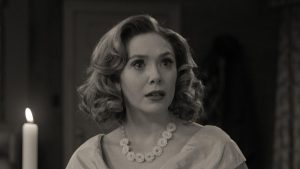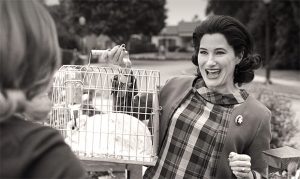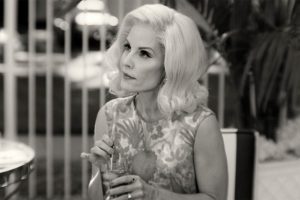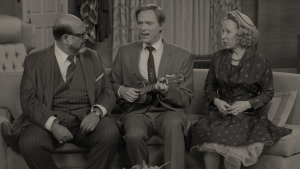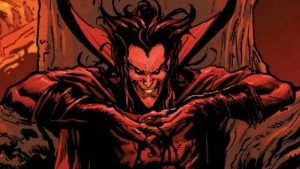SPOILERS FOR WHAT IF…? AHEAD!
My main question coming into What If…?, and the only one this premiere episode actually had to answer, is what the framing device around each episode would be. After all, What If…? isn’t your typical Marvel Disney+ show – and not only because it’s the studio’s first animated series, but because it’s also an anthology of sorts. Each episode is largely self-contained, and each follows a different timeline in the vast Marvel Multiverse, where a single change to the canon we know can create a wholly different world and history.
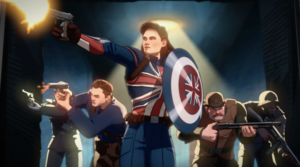
My questions were mostly regarding the logistics of this bold creative choice. Would we be plunged straight into the action of a whole new universe each week, much like with WandaVision? Would each episode lead into the next, even if they were self-contained and separate? How prevalent would Jeffrey Wright’s The Watcher actually be as a narrator, and how helpful would he be as a guide to the Multiverse? The answers: no, not really, and…*vague hand gesture*
Don’t get me wrong: The Watcher has an important role, especially for general audiences. Even if you haven’t seen the finale of Loki and don’t actually know what the Multiverse is, The Watcher gives you all the information you need to know upfront – which is to say, very little, yet just enough to get a general understanding of what’s going on. The Watcher bookends the first episode with a little narration at the beginning that very swiftly and deftly picks out the nexus event in this alternate timeline that leads to Peggy Carter (voiced by her original actress, Hayley Atwell) becoming Captain Carter, and then a brief closing monologue about how he never interferes in the timeline.
Sadly, The Watcher doesn’t show up at all between those two points – which makes him a lot less interesting as a character. I get that he can’t, or won’t, interfere with the timelines he watches over even though they’re already in chaos thanks to Loki and Sylvie, but it would have been nice if he at least took a more active role as a narrator, giving us some colorful commentary on the action of each episode. He certainly has strong feelings and opinions on things. I would like to hear more from him.
And I almost feel as though that kind of commentary would have helped to save this episode from turning into the choppily-edited, massively-abridged, unfocused highlight reel of Captain Carter’s life and career that it very quickly becomes.
You know the little Marvel: Legends recaps that Marvel’s been releasing in front of each of their shows that focus on a returning character’s greatest moments in the MCU? This episode plays like a recap, except that each of the “greatest moments” in this case seems to have been selected not for what they say about Captain Carter as a character, certainly not for what they illuminate about the differences between her and Steve Rogers (Josh Keaton), but for how they reference, parallel, or directly overlap with Steve’s own adventures as Captain America in The First Avenger – thereby robbing Captain Carter of much of her individuality and independence.
In terms of runtime, this episode also feels like a highlight reel at a lean twenty-nine minutes (not including credits) – and rather than work with that time limitation and design this episode with the style and aesthetic of a 1940’s news reel, which would have been really clever and fun, this episode just feels breathless and hectic. Everyone is delivering their dialogue at breakneck speed, sometimes barely even pausing between lines to a point that becomes seriously grating on the ear – again, as though it’s being edited on the assumption that the stuff in between the dialogue isn’t important.
There’s nothing I would call a unique character moment, because there’s barely any space to fit a character moment in here at all – so the episode relies on recycling beats from The First Avenger, but with Steve and Peggy’s roles swapped. Just like in the universe we left behind, they still fall in love, one of them still ends up sacrificing themselves to save the world and returns seventy years later, and they even make the exact same promise to share a dance one day, except that here it just comes out of the blue and feels totally unearned. Dominic Cooper’s Howard Stark comes closest to having a character moment, and it’s literally just one line about a weekend with Hedy Lamarr.
So what do we get instead? A lot of plot. In fact, the entire plot of The First Avenger – a two-hour and four-minute long movie – condensed into just less than half an hour. And that’s because this episode basically follows The First Avenger beat-by-beat, without really diving into the unique consequences of Peggy Carter specifically not only becoming the first Super-Soldier, but quite forcefully seizing the serum after an incident in Doctor Erskine (Stanley Tucci)’s laboratory that forces her to take the lead.

The nexus event that’s supposed to precipitate everything is Peggy refusing to leave the laboratory floor during the experiment on Rogers. But What If…? recreates the scene with a couple of other noticeable alterations that you’d think might also mess up the timeline, including the addition of John Flynn (Bradley Whitford) – an obscure character from Marvel One-Shot: Agent Carter – and the fact that everyone else is on the laboratory floor along with Peggy, which makes this feel like less of an empowering feminist moment and more like a joint decision by all the Strategic Science Reserve top brass. The date of the Red Skull (Ross Marquand)’s raid on Tønsberg is also pushed back, and somehow despite having the Tesseract in his possession for a far shorter period he’s suddenly able to summon monsters from other dimensions?
But from that point on, the basic structure of the story remains unchanged. A string of awesome action sequences prevent the episode from ever becoming downright boring, but it’s not exactly entertaining either once you realize that Peggy is no longer getting to make her own decisions, she’s just running through a checklist of all the things Steve did that she now has to repeat. Rescuing Bucky and the other guys of the 107th, and forming the Howling Commandos? Check. Losing her best friend during a mission in the Swiss Alps that involves ziplining onto a Nazi bullet train? Check. Storming a HYDRA fortress, and supposedly dying in a heroic self-sacrifice? Also check.
And that really annoys me because there’s so much more this episode could have played with, even in its slim runtime! Peggy is a much more forceful presence than Steve Rogers, both in the main timeline and this one, so it makes sense that she’d get onto the front lines a lot faster than Steve, without going through the awkward middle stage of being sent around the US on a military propaganda tour, but we could have explored more of how Peggy being a woman affects the way she’s expected to behave as Captain Carter, and how she defies the expectations of her in her own way.
For instance, perhaps the SSR and the US military wouldn’t have felt comfortable about flaunting her as they did with Steve – after all, she doesn’t perform her first heroic deed in public in this timeline, so there’s no pressure on them to do so. We could have dived into the covert side of the SSR, with Peggy being used only on secretive stealth-missions while the SSR fast-tracks an effort to find her replacement behind her back. They basically find one in Steve Rogers, ironically. He becomes a kind of proto-Iron Man alongside Captain Carter, donning a flying metal suit called the HYDRA Stomper. But the episode is too busy working in their romance to explore any conflict there.
It would also have been interesting to see how Peggy embodies the marriage of British brawn with American (and technically German) science, and how that affects the political situation in her universe. She might have been hailed as a symbolic representation of the alliance between the US and the UK, and both countries might have fought over her behind the scenes. What If…? certainly emphasizes her Britishness in a way the movies didn’t, with Captain Carter wearing the Union Jack on both her suit and vibranium shield, all while still working for the US. But this odd detail is somehow never mentioned, and What If…? doesn’t so much as toy with the idea of calling her Captain Britain.
And what about the effect it has on her enemies? In The First Avenger, I always got the sense that the Red Skull’s loathing of the US, which even led to him trying to bomb New York, was derived from his intense personal grudge against Steve Rogers. But in What If…?, his grudge is with Peggy Carter – and though the episode barely touches on their dynamic because time restraints, I can’t help but wonder if he’d have launched a full-scale attack on her country of England instead of targeting Steve Rogers’ hometown? I’d have loved to have seen some twist on the Battle of Britain.
Speaking of battles, let’s touch on one of my favorite things about the episode – the action. Animation has always been a great medium for action-heavy stories, because in animation you’re free to play fast and loose with logic and the laws of physics in ways that live-action can’t consistently replicate, even if you are willing to endanger the lives of countless stunt doubles and pay for massive amounts of CGI. Think of how Ahsoka Tano moves in The Clone Wars and in Star Wars: Rebels, with the kind of fluidity and flexibility that make her fight scenes mesmerizing to watch – that’s how Captain Carter moves in What If…?. She flies, she twirls, she high-kicks Nazis, we love to see it.
But that’s what makes it so disappointing that we don’t get to see more of her as a character – or even just anything that feels like a direct consequence of Peggy Carter, specifically, becoming a Super-Soldier. The very structure of What If…? would seem to allow for more character-driven storytelling, even necessitate it. Characters making decisions they’re not supposed to is how we end up with alternate timelines in the MCU. But Peggy is stuck doing everything Steve did, the only real twist being that she looks a hell of a lot cooler (wearing flawless victory curls in the heat of battle is a whole mood), and fights better too. Oh yeah, and the Red Skull gets crushed to death by a cosmic Cthulhu that I’m stubbornly choosing to believe is Hive from Agents Of S.H.I.E.L.D., but that really doesn’t have anything to do with Peggy.

Yet that, I’m afraid, is how many of the episodes of What If…? that simply revolve around one character taking up another’s mantle will ultimately play out – as if the plot beats are more important than the characters and their individual actions, as if it doesn’t really matter who’s the first Avenger because they’re still going to have to do all the same things as Steve Rogers and end up in the same place eventually. I hope that once we get into episodes with more unique concepts, we’ll see more character-driven storytelling and perhaps have a chance to slow down a bit and actually explore all these new corners of the Multiverse that we just kind of rushed through in this premiere.
Episode Review: 6.5/10
